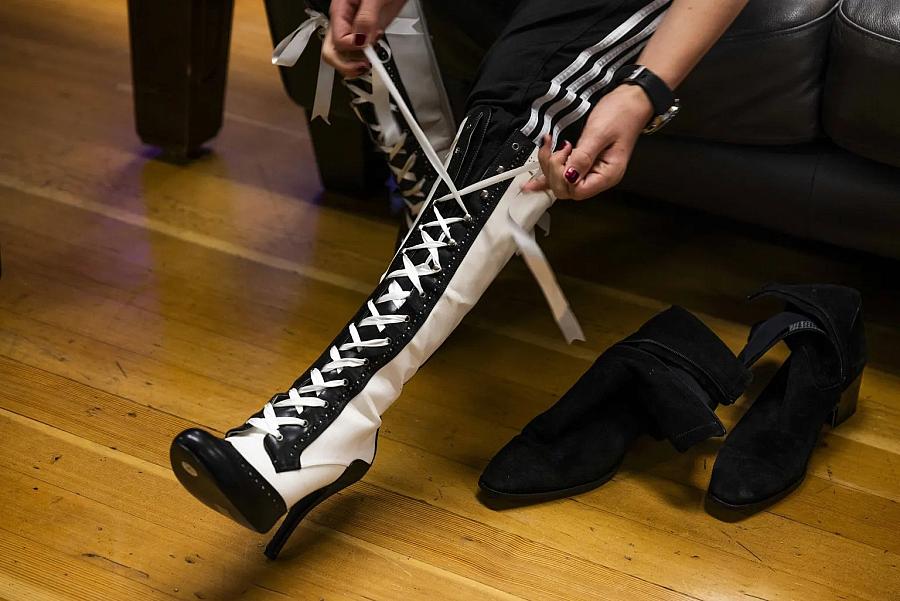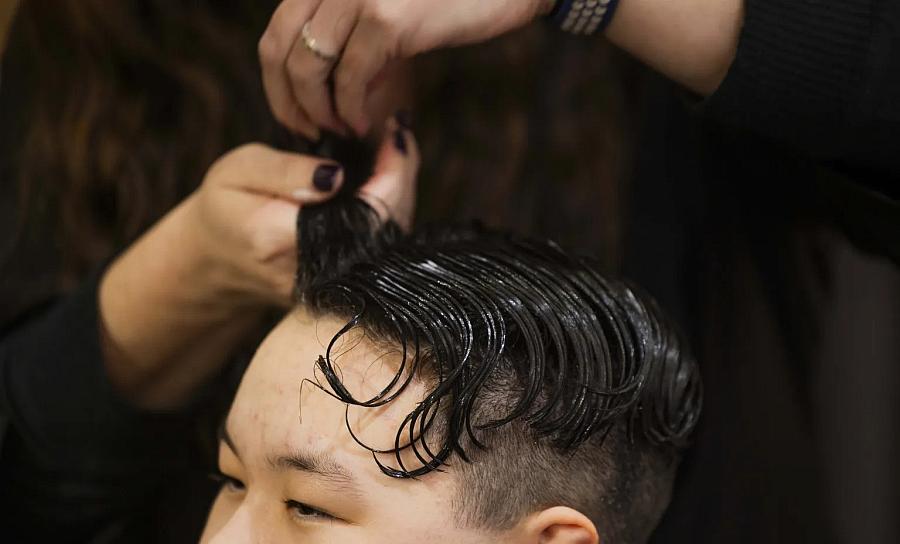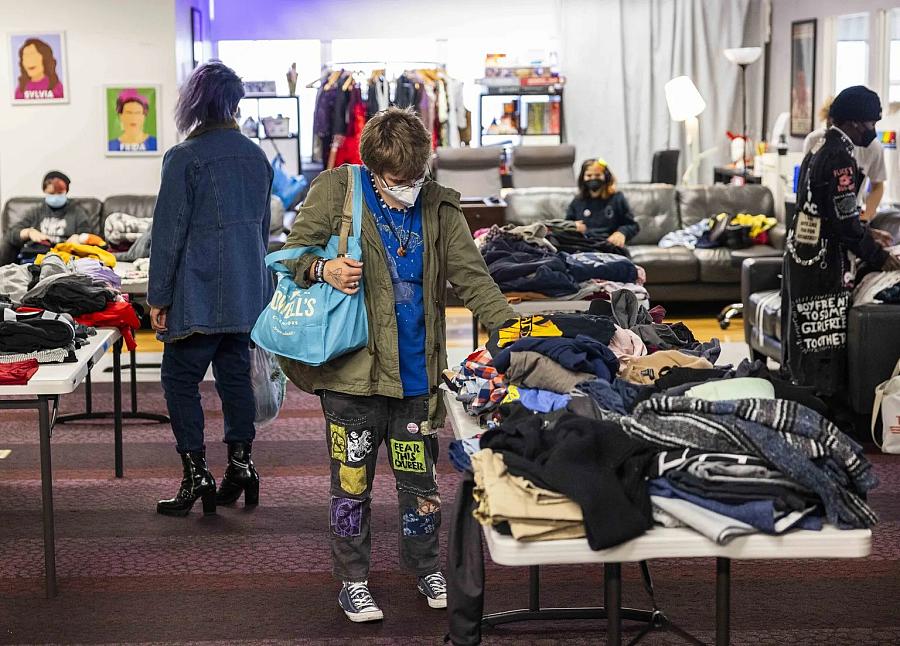Inside a clothing swap: Care for trans youth beyond medicine and surgery
The story was originally published by the The Seattle Times with support from our 2023 National Fellowship.

Ollie, 12, right, browses for new wardrobe styles. Ollie moved to Washington with their family about two years ago and says they’ve liked it more than past homes because of the supportive trans and queer communities here.
Daniel Kim / The Seattle Times
It was a particularly busy morning inside a downtown Tacoma community center on one drizzly fall weekend. Racks of colorful clothing filled the space. Silver and gold sparkly gowns hung in one corner. Tables were lined with cowboy boots and sneakers, collections of bandannas and various skirts and shorts.
Everything was ready for a fall clothing swap at the Rainbow Center, which serves LGBTQ+ communities in the Pierce County area. When doors opened, a line of people wrapped in scarves and rain jackets, already waiting outside, streamed in.
“Welcome to this year’s queer clothing swap!” a staffer hollered.
Swaps like this are a fun opportunity for a seasonal wardrobe change — but the main goal is to provide a space for queer and trans communities to explore their gender identity and expression through fashion, one staffer said.

A clothing swap attendee laces up an eye-catching high-heeled boot at the Rainbow Center in Tacoma.
Daniel Kim / The Seattle Times
Affirming clothes are often a key part of social support, especially for younger people without access to medical care, said Charlie Best, the Rainbow Center’s former education manager. So are affirming haircuts and makeup, along with name and pronoun changes, he added.
“That’s a piece that often doesn’t get talked about at all,” said Best, who currently works as a diversity, equity and inclusion consultant in Pierce, King and Thurston counties. “This is not a replacement for essential medical care, but I think often it’s an all-or-nothing mentality, and youth may feel like, ‘I have to fully transition in order to be accepted.’”
At Seattle’s LGBTQ+ Center on Capitol Hill, staffers think about gender-affirming care with a three-pillared approach: social, medical and surgical, said Bekah Telew, the center’s former co-executive director. Hormone medication and surgery can be medically necessary for some trans and gender diverse youth, while community spaces like Seattle’s LGBTQ+ Center often mainly focus on the social side.
“We want to create spaces that are affirming and celebratory,” Telew said.

Gowns are hung in a corner of the Rainbow Center. Donated items like these had been pouring into the center weeks before the fall clothing swap.
Daniel Kim / The Seattle Times
Back at the fall clothing swap, attendees continued to fill the Rainbow Center. The event was co-hosted by Planned Parenthood and the Oasis Youth Center, a Tacoma organization that supports LGBTQ+ kids, teens and young adults.
One Puyallup teen left happy with their haul: two Pride tees, a shirt with a fiery phoenix and three cardigans (one for them, one for their mother and one for their grandmother). The 15-year-old heard about the swap through Oasis, which they discovered in June.
“I just love it there,” said M, whose family requested they be identified by first initial to protect their identity and safety. “Everyone is so accepting, and I like being around other kids like me who are not white and are also trans and not cis.”
M now spends most evenings each week at Oasis, playing games and participating in the center’s movie nights and weekend outings. One Saturday, they went to a bonsai museum. On another weeknight, they all watched Disney’s “Encanto.” M also sees a gender-affirming therapist there through the center’s free mental health voucher program.
“Oasis has literally been life-changing for [M], in terms of their depression,” their mom, Emily, said in an interview.
M came out as gender fluid two years ago while in seventh grade at a private religious school in Puyallup. They first realized they were not straight, and eventually had fewer and fewer “girl days,” they said.

M gets their hair styled last month at a Puyallup hair salon. The ninth grader came out as gender fluid two years ago. Haircuts and clothes are a big part of gender affirmation.
Daniel Kim / The Seattle Times
“It did not go well,” M said. They struggled with depression and a suicide attempt as a result of racist and anti-LGBTQ+ bullying.
“They were coming home from school really sad every day,” M’s mom said. “I was losing them.”
They’ve slowly started feeling more comfortable after switching to a public junior high, finding relief in a zero bullying/harassment policy that teachers “actually enforce,” M said. The new school, plus finding friends and resources at Oasis this year, has helped.
Now in ninth grade, M plays bass clarinet, and was recently cast in a school play. They have a haircut appointment every four weeks. And art, baking and their family — especially their older brother and Abby, their beloved brown poodle — are bright spots on hard days.
“Oasis has made such a big difference,” said Emily. “It’s helped bring them back to themselves.”
Haden Gibson, another attendee at the fall clothing swap, has been coming to the Rainbow Center since they were 7. Smiling, the now 19-year-old browsed through a rack of shiny blouses.
“It’s a place where you can express your gender identity to the fullest extent,” Gibson said. “It’s a very beautiful sanctuary we have.”

Haden Gibson, 19, checks out a stack of T-shirts at the Rainbow Center, “a very beautiful sanctuary that we have.” Gibson has been going to the center since age 7.
Daniel Kim / The Seattle Times

